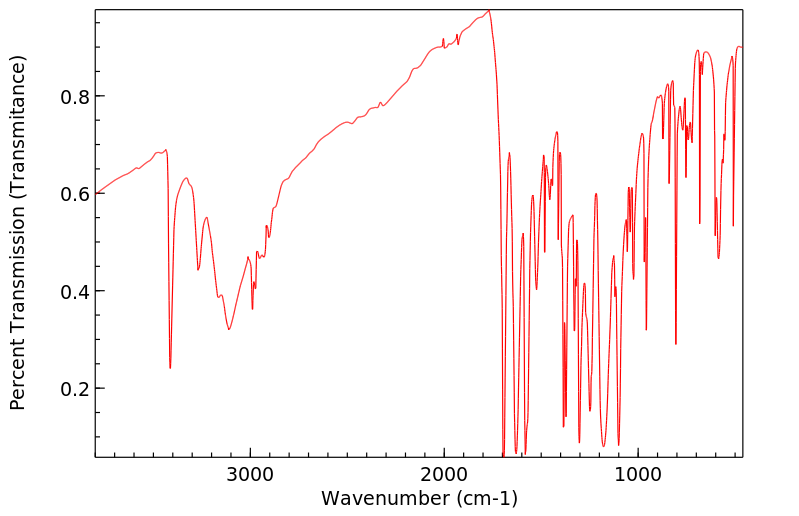2-乙硫基-4-氨基嘧啶-5-羧酸乙酯 | 778-97-2
中文名称
2-乙硫基-4-氨基嘧啶-5-羧酸乙酯
中文别名
4-氨基-2-乙硫基-5-嘧啶甲酸乙酯;2-乙巯基-6-氨基嘧啶甲酸乙酯;2-乙硫基-4-氨基-5-嘧啶甲酸乙酯
英文名称
Ethyl-4-amino-2-ethylthio-5-pyrimidin-carboxylat
英文别名
4-Amino-2-ethylmercapto-5-carbethoxy-pyrimidin;ethyl 4-amino-2-(ethylthio)pyrimidine-5-carboxylate;4-amino-2-ethylsulfanyl-pyrimidine-5-carboxylic acid ethyl ester;2-ethylsulfanyl-4-amino-pyrimidine-5-carboxylic acid ethyl ester;4-amino-2-(ethylthio)-5-pyrimidinecarboxylic acid, ethyl ester;2-Aethylmercapto-4-amino-pyrimidin-5-carbonsaeure-aethylester;2-Aethylmercapto-6-amino-pyrimidin-5-carbonsaeure-aethylester;4-Amino-2-(ethylthio)-5-pyrimidinecarboxylic acid ethyl ester;ethyl 4-amino-2-ethylsulfanylpyrimidine-5-carboxylate
CAS
778-97-2
化学式
C9H13N3O2S
mdl
MFCD00047375
分子量
227.287
InChiKey
ODFLPYCOQXPONS-UHFFFAOYSA-N
BEILSTEIN
——
EINECS
——
-
物化性质
-
计算性质
-
ADMET
-
安全信息
-
SDS
-
制备方法与用途
-
上下游信息
-
文献信息
-
表征谱图
-
同类化合物
-
相关功能分类
-
相关结构分类
物化性质
-
熔点:104-106°C
-
溶解度:溶于氯仿
计算性质
-
辛醇/水分配系数(LogP):1.8
-
重原子数:15
-
可旋转键数:5
-
环数:1.0
-
sp3杂化的碳原子比例:0.444
-
拓扑面积:103
-
氢给体数:1
-
氢受体数:6
安全信息
-
危险品标志:Xi
-
安全说明:S22,S36/37/39
-
危险类别码:R36/37/38
-
海关编码:2933599090
SDS
上下游信息
-
上游原料
中文名称 英文名称 CAS号 化学式 分子量 4-氨基-2-巯基嘧啶-5-羧酸乙酯 ethyl 4-amino-2-mercapto-pyrimidine-5-carboxylate 774-07-2 C7H9N3O2S 199.233 6-氨基-2-硫氧代-1,2-二氢嘧啶-5-羧酸乙酯 ethyl 4-chloro-2-ethylthiopyrimidine-5-carboxylate 2223-96-3 C9H11ClN2O2S 246.718 -
下游产品
中文名称 英文名称 CAS号 化学式 分子量 4-氨基-5-嘧啶羧酸乙酯 ethyl 4-aminopyrimidine-5-carboxylate 65195-35-9 C7H9N3O2 167.167 2-乙硫基-5-羟甲基-6-氨基嘧啶 (2-ethylmercapto-4-amino-pyrimidin-5-yl)-methanol 98432-26-9 C7H11N3OS 185.25 4-氨基-2-羟基嘧啶-5-甲酸乙酯 ethyl 6-amino-2-oxo-1H-pyrimidine-5-carboxylate 20187-46-6 C7H9N3O3 183.16
反应信息
-
作为反应物:描述:参考文献:名称:Synthesis of 5-Hydroxymethylcytosine摘要:DOI:10.1021/ja01608a060
-
作为产物:描述:参考文献:名称:RESEARCHES ON PYRIMIDINES. CXIV. THE REARRANGEMENT OF 2-ETHYLMERCAPTO-5-CARBETHOXY-6-THIOCYANPYRIMIDINE INTO ITS ISOTHIOCYANATE MODIFICATION1摘要:DOI:10.1021/ja01367a045
文献信息
-
Human Caliciviruses Are a Significant Pathogen of Acute Sporadic Diarrhea in Children of Santiago, Chile作者:Miguel L. O'Ryan、Nora Mamani、Aldo Gaggero、Luis Fidel Avendaño、Susana Prieto、Alfredo Peña、Xi Jiang、David O. MatsonDOI:10.1086/315874日期:2000.11Human caliciviruses (HuCVs) are increasingly recognized as common pathogens that cause acute sporadic diarrhea in children; however, regional antigenic and genetic diversity complicate detection techniques. Stool samples from children seeking medical attention in 2 outpatient clinics, a large emergency department, and 2 hospital wards were evaluated for HuCVs by reverse transcription—polymerase chain reaction, using primers based on a conserved sequence of the polymerase region of a previously sequenced Chilean strain. HuCVs were detected in 53 (8%) of 684 children 1 month to 5 years of age (mean, 13 months). Detection occurred year-round without a clear seasonal peak, and detection frequency declined from 16% in 1997 to 2% in 1999. The decline may have been due to a change in virus genotype. HuCVs are a significant pathogen of acute sporadic diarrhea in Chilean children, and continuous characterization of genetic diversity will be crucial for appropriate detection.人杯状病毒(HuCVs)作为一种常见的病原体,导致儿童急性散发性腹泻的作用日益受到重视;然而,其抗原性和遗传学的区域多样性复杂化了检测技术。本研究采用逆转录-聚合酶链反应,以基于先前智利分离株的聚合酶区域保守序列设计的引物,对两所门诊诊所、一家大型急诊科和两家医院病房中因病就诊的儿童粪便样本进行了HuCVs检测。在684名1个月至5岁的儿童中(平均年龄13个月),有53名(8%)检出HuCVs。检测全年均有发生,无明显季节高峰,且检出频率从1997年的16%下降至1999年的2%。这种下降可能归因于病毒基因型的改变。HuCVs是智利儿童急性散发性腹泻的重要病原体,而持续对遗传多样性进行表征对于正确检测至关重要。
-
A Method for the Reductive Scission of Heterocyclic Thioethers作者:Thomas H. Graham、Wensheng Liu、Dong-Ming ShenDOI:10.1021/ol2026813日期:2011.12.2substituent at the 2-position relative to a ring heteroatom. The convenient and straightforward method is demonstrated with reactants which are not compatible with the standard Raney nickel conditions such as sulfides, sulfones, and thiophenes. In addition, benzyl esters, benzyl amides, and benzyl carbamates are tolerated by the reductive reaction conditions.
-
Neue Benzisoselenazolone, Verfahren zu ihrer Herstellung und diese enthaltende Pharmazeutische Präparate
-
Researches on Pyrimidines. CXLVIII. Action of Chlorine on Mercaptopyrimidines作者:James M. Sprague、Treat B. JohnsonDOI:10.1021/ja01314a063日期:1935.11
-
Johnson, American Chemical Journal, 1909, vol. 42, p. 506,510, 512作者:JohnsonDOI:——日期:——
表征谱图
-
氢谱1HNMR
-
质谱MS
-
碳谱13CNMR
-
红外IR
-
拉曼Raman
-
峰位数据
-
峰位匹配
-
表征信息
同类化合物
(S)-3-(2-(二氟甲基)吡啶-4-基)-7-氟-3-(3-(嘧啶-5-基)苯基)-3H-异吲哚-1-胺
(6-羟基嘧啶-4-基)乙酸
(4,5-二甲氧基-1,2,3,6-四氢哒嗪)
鲁匹替丁
马西替坦杂质7
马西替坦杂质4
马西替坦杂质
马西替坦原料药杂质D
马西替坦原料药杂质B
马西替坦
顺式-4-{[5-溴-2-(2,5-二甲基-1H-吡咯-1-基)-6-甲基嘧啶-4-基]氨基}环己醇
非沙比妥
非巴氨酯
非尼啶醇
青鲜素钾盐
雷特格韦钾盐
雷特格韦相关化合物E(USP)
雷特格韦杂质8
雷特格韦EP杂质H
雷特格韦-RT9
雷特格韦
阿西莫司杂质3
阿西莫司
阿脲四水合物
阿脲一水合物
阿维霉素
阿米美啶
阿米洛利
阿米妥钠
阿洛巴比妥
阿普瑞西他滨
阿普比妥
阿巴卡韦相关化合物B(USP)
阿卡明
阿伐那非杂质V
阿伐那非杂质1
阿伐那非杂质
阿伐那非中间体
阿伐那非
铂(2+)二氯化6-甲基-1,3-二{2-[(2-甲基丙基)硫烷基]乙基}嘧啶-2,4(1H,3H)-二酮(1:1)
钴1,2,3,6-四氢-2,6-二氧代嘧啶-4-羧酸酯(1:2)
钠5-烯丙基-4,6-二氧代-1,4,5,6-四氢-2-嘧啶醇酸酯
钠5-乙基-4,6-二氧代-1,4,5,6-四氢-2-嘧啶醇酸酯
钠5-(2-溴丙-2-烯基)-5-丁烷-2-基-4,6-二氧代-1H-嘧啶-2-醇
醌肟腙
酒石酸噻吩嘧啶
那可比妥
辛基2,6-二氧代-1,2,3,6-四氢-4-嘧啶羧酸酯
赛乐西帕杂质3
赛乐西帕KSM3







